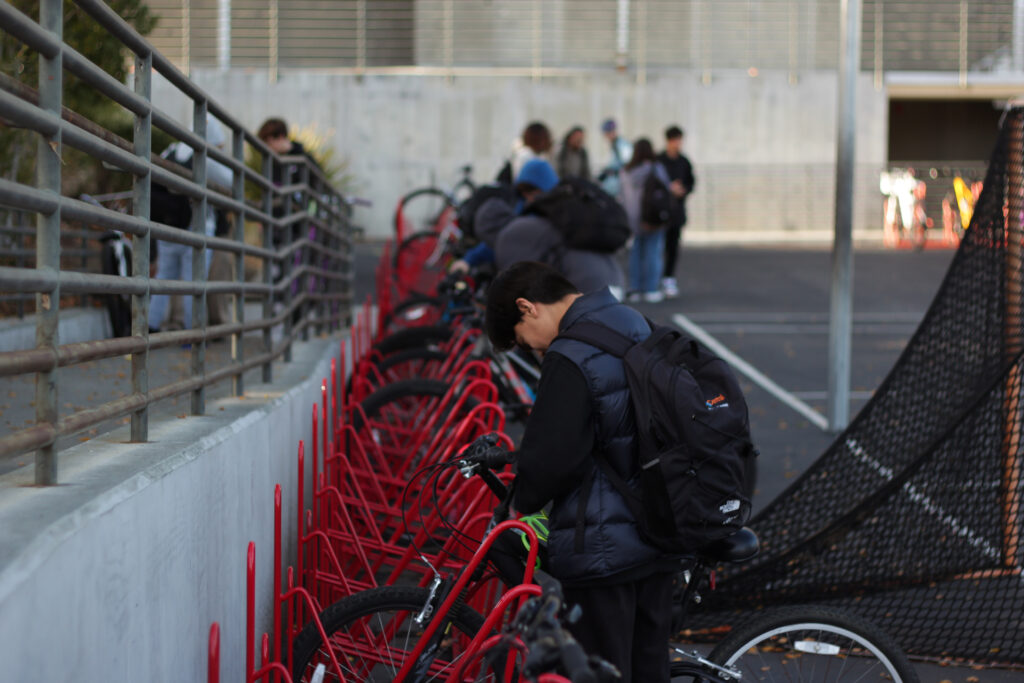
At Aragon, several students and teachers utilize alternate means of transportation such as biking and scootering to arrive or leave school instead of a car.
History teacher Jon Felder has been biking to school since he first started working at Aragon.
“I live … on the other side of the city in the Shoreview neighborhood, and it’s a good way for me to get across town,” Felder said. “When I started working here before [COVID-19], there was a lot of traffic on Alameda. There’s all these schools … so it gets busy in the mornings and afternoons … So I decided I would bike.”
For Felder, kicking off his morning with a bike ride to school helps prepare him for the long day ahead.
“I teach starting at 8:30 a.m., so one of the challenges is getting some energy before the first period,” Felder said. “It’s uphill from where I live to get to school, so that kind of gets the blood flowing [and] wakes me up.”
While certainly an energizing experience, biking has its dangers. Sharing the road with cars, for example, has been a challenge for many bikers on campus. Some students described getting hit by a car, resulting in bruised hips and crutches over a few weeks.
“If you ride on the sidewalk, then you get yelled at by the people on the sidewalk,” said sophomore Gerald Schwab. “If you’re out in the street, then the cars honk at you.”
In her experience, most traffic occurs within five minutes before and after school, making the majority of her trips to and from school fairly smooth.
Weather can be another obstacle. When San Mateo received a large amount of rain, some bikers used equipment to avoid arriving at school soaked.
“I’ve had to invest in a waterproof … jacket and pants,” said math teacher Craig Sipple, who uses a combination of biking and public transportation to get from San Francisco to Aragon each morning. “It does add a little extra to the commute, having to gear up, but … if you invest in the right gear, you can stay dry.”
Many students and teachers find that the benefits of biking to school outweigh the potential disadvantages. For Sipple, the environmental benefits of biking were one of the main reasons why he sold his car and began using his bike as his primary means of transportation.
“[Biking] is a good way for me to get across town”
Carbon dioxide, emitted by cars, is one of the main contributors to global climate change. When greenhouse gasses like carbon dioxide are released into the air, they trap heat in the atmosphere, creating a domino effect of environmental consequences such as melting ice sheets, habitat loss and endangered species.
According to a study conducted by the University of California, Los Angeles, moderate increases in bicycle use in place of cars could prevent an estimated six to 14 million tons of carbon dioxide from entering the atmosphere each year.
Beyond biking, there are other environmentally-friendly methods of transportation that students use to get to school instead of driving. For junior Edward Gomez, it’s the electric scooter.
“It’s a foldable scooter,” Gomez said. “It’s not too heavy — It’s like 25 pounds. The charge time is around four to five hours … It’s really convenient.”
When scootering to school, Gomez experiences some of the same troubles as bikers when it comes to sharing the road with cars.
“Cars just zoom by and typically don’t stop,” Gomez said. “There’s no stop signs indicating that they should stop, or any speed bumps.”
But while dangers on the road have been a challenge, Gomez has been able to avoid accidents and collisions by practicing caution. Outside of school, he also uses his scooter to travel to other places around San Mateo.
“I typically go shopping,” Gomez said. “I sometimes go downtown or anywhere that’s not … too far.”
Although both biking and scootering have their potential dangers, they are a feasible option for transporting people to and from school. The environmental, health and recreational benefits of these alternate forms of transportation are valued by many students and teachers alike.
“Biking to school is a wonderful thing,” said sophomore Chloé Levadoux. “It’s great for our planet, it brings people together and it creates community.”



